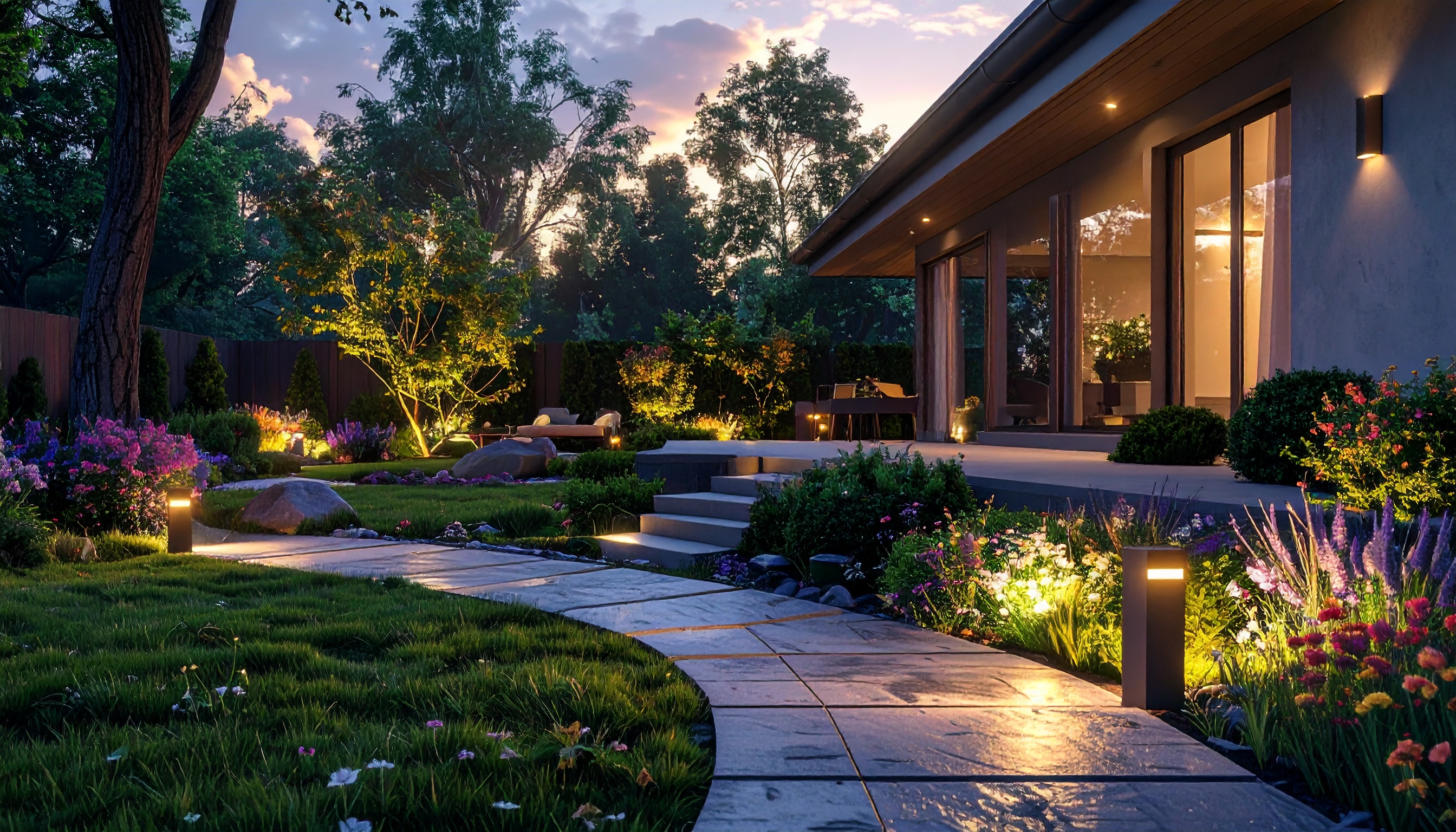When you start thinking about upgrading your outdoor lighting, the first question that pops into your head is usually, "What's this going to cost me?" The short answer is that a professional landscape lighting installation cost for most homeowners typically lands somewhere between $3,000 and $6,000. That figure generally covers the whole nine yards—from the initial design to flicking the switch for the first time.
What Does Landscape Lighting Really Cost?
Let's be clear: investing in landscape lighting isn't just another home improvement project. It's a smart upgrade that pays you back in curb appeal, safety, and sheer enjoyment. A professionally designed system can transform a dark, overlooked yard into a warm, inviting outdoor living area, effectively extending your home's footprint long after the sun goes down.
That initial cost range reflects a complete, turn-key installation. Here in the United States, the final price tag can shift based on your property's size, the specific fixtures you fall in love with, and how complex the design gets. On average, most projects hover around the $4,000 mark. For a closer look at how these costs break down, you can find some excellent comprehensive guides on landscape lighting costs.
The visual below gives you a quick snapshot of how costs scale with different property sizes.
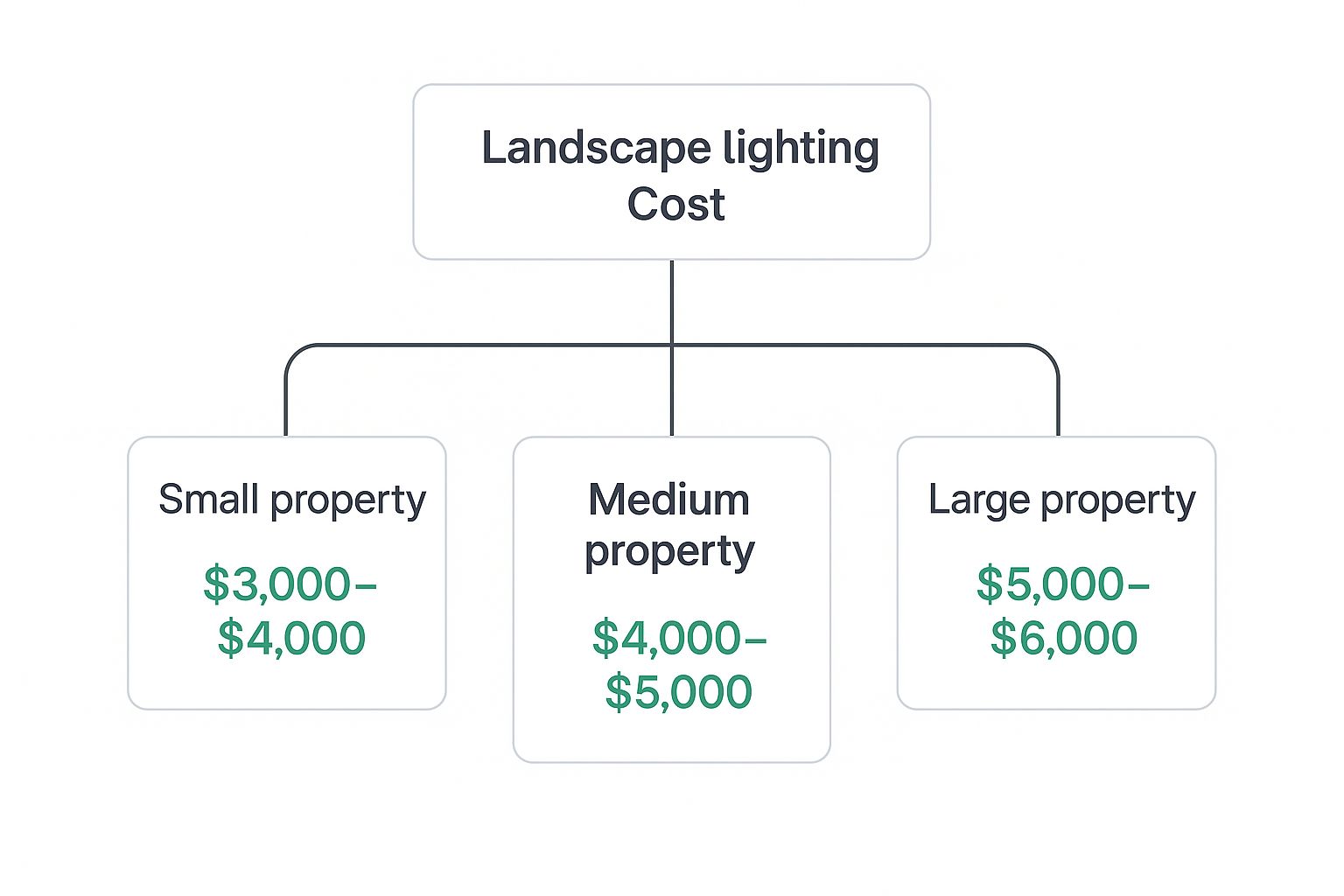
As you can see, the scope of the project is the biggest driver of the final price. This actually gives you a lot of flexibility to find a budget that makes sense for your home and your goals.
To give you a clearer picture, here's a quick summary of what you might expect to invest based on the number of lights you need.
Beyond the Price Tag: The True Value
While these numbers are a great starting point, the real value of professional landscape lighting goes far beyond what's on the quote. It's an investment in your home's entire atmosphere and how you use your space. Well-placed lights don't just illuminate; they highlight your home’s best architectural features and create an incredible ambiance for family and guests.
Think of it as setting the stage for your home, every single night. The right lighting design can:
- Boost Curb Appeal: A beautifully lit home just pops. It creates a high-end, polished look that can seriously elevate your property's perceived value.
- Improve Safety and Security: Lighting up walkways, steps, and shadowy corners is a simple way to prevent trips and falls. It's also a powerful deterrent for potential intruders.
- Extend Your Living Space: Suddenly, your patio, deck, and garden become usable spaces after dark. They transform into functional, beautiful extensions of your home, perfect for evening gatherings or just relaxing under the stars.
When you see it this way, the landscape lighting installation cost stops being a simple expense. It becomes a valuable, long-term investment in your property's beauty, safety, and your family's enjoyment of it.
With this foundation, we can start digging into the details. The next sections will break down exactly what goes into a professional quote—from the fixtures you choose to the expert labor needed for a flawless, long-lasting installation. This will give you the knowledge you need to make confident decisions and create a budget that brings your vision to life.
Deconstructing Your Lighting Installation Quote
Ever gotten a quote from a contractor and felt like you needed a secret decoder ring to figure it out? I get it. A professional landscape lighting quote isn't just a single number; it's a complete roadmap showing every single part that goes into bringing your outdoor vision to life. Once you understand the pieces, the total landscape lighting installation cost makes a lot more sense, and you can talk to your installer with total confidence.
At its heart, every quote boils down to two main things: materials and labor. Think of it like commissioning a custom piece of furniture. You've got the cost of the beautiful, high-quality wood and hardware, and then you have the cost for the skilled artisan who meticulously cuts, assembles, and finishes it into a masterpiece.
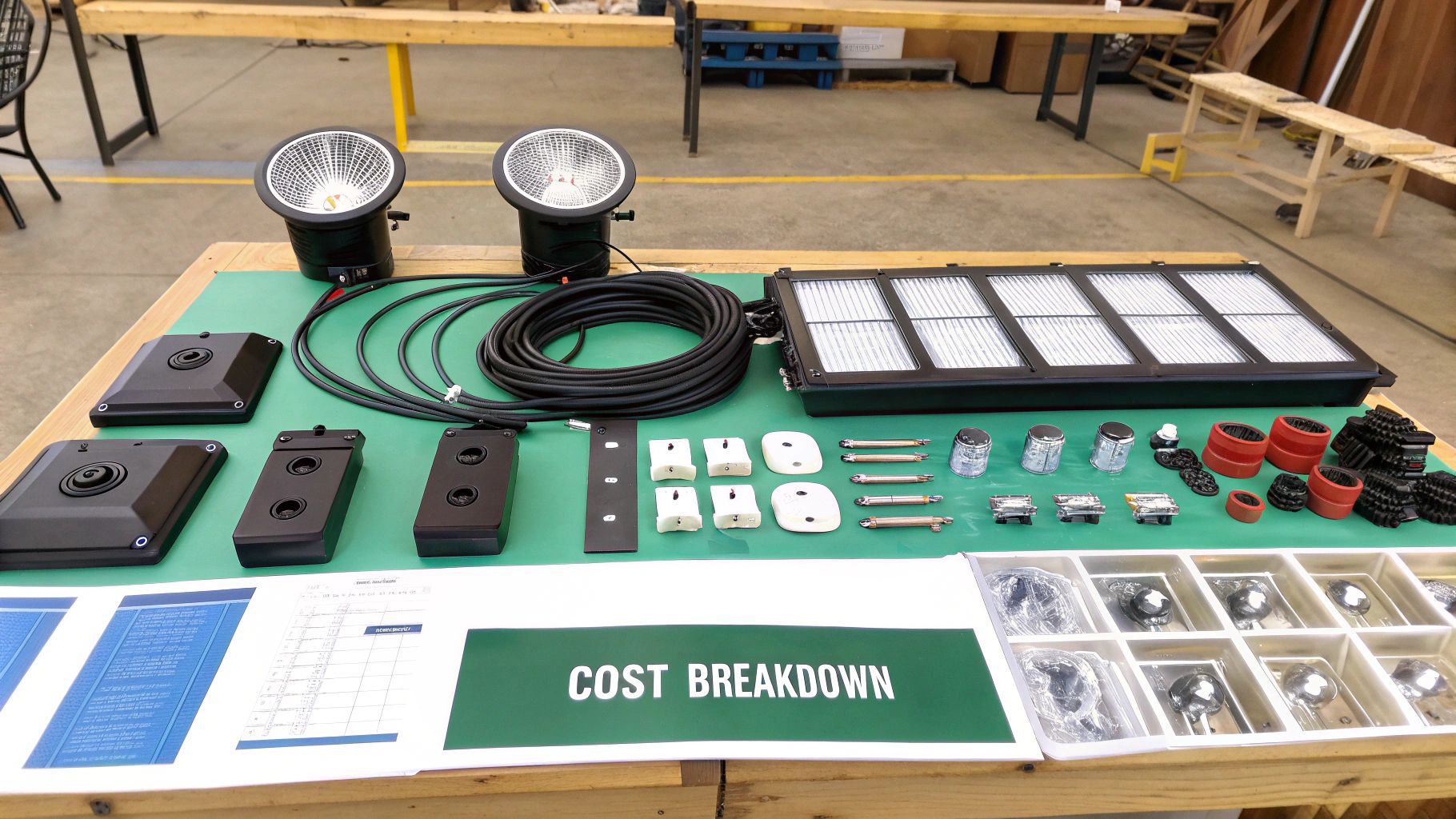
Let's start by unpacking the physical items you're actually paying for.
The Hard Costs of Materials
We call these the "hard costs"—all the tangible components that will make up your new lighting system. This is the most straightforward part of any quote because it represents the actual products we'll be installing on your property.
You’ll typically see three main categories of material costs:
- Fixtures: These are the lights themselves—the stars of the show! This covers everything from elegant path lights and dramatic uplights to discreet well lights and focused spotlights. The price tag here can swing quite a bit depending on the material (solid brass is far more durable and pricier than aluminum), the brand, and the specific style you're going for.
- Transformer: If the fixtures are the stars, the transformer is the heart of the entire system. This critical piece of equipment takes the standard 120-volt power from your house and safely converts it to a low-voltage 12 volts for your lights. A top-quality, properly-sized transformer isn't just a suggestion; it's absolutely essential for the safety and longevity of your system.
- Wiring and Connections: This bucket includes all the direct-burial, low-voltage cable that runs from the transformer out to each fixture. It also covers the waterproof connectors, mounting stakes, and other small but vital bits of hardware that ensure your system will stand up to the Orange County elements for years to come.
These are the foundational building blocks of any truly professional installation.
The Soft Costs of Professional Labor
Labor is often the biggest piece of the pie, and for very good reason. This is where you’re investing in expertise, safety, and artistry. These are the "soft costs" that make the difference between a weekend DIY project that fails in a year and a stunning, durable lighting system that lasts for decades.
Professional labor isn't just about digging holes. It covers a whole range of crucial tasks:
- System Design: A true lighting pro doesn't just scatter lights around your yard. They carefully analyze your landscape's best features, your home's architecture, and what you want to achieve to create a cohesive and breathtaking design.
- Trenching and Wire Burial: Installers painstakingly dig narrow, precise trenches to bury every inch of wiring. This keeps it hidden from sight and safe from lawnmowers, edgers, or foot traffic, creating that seamless, professional finish.
- Fixture Installation and Connection: Each light is set precisely, staked securely into the ground, and then connected to the main wire with completely waterproof seals. This step is critical for preventing moisture from getting in, which is the number one killer of amateur lighting jobs.
- Final Adjustments and Aiming: The real magic happens after the sun goes down. Your installer will walk the property with you, fine-tuning the angle and position of every single light to create the perfect ambiance, kill any annoying glare, and make sure every feature is highlighted just right.
A professional quote reflects not just the time it takes to dig and wire, but the years of experience needed to design a system that is safe, efficient, and artistically beautiful. This expertise is the true value behind the labor cost.
How Your Choice of Fixtures Shapes the Budget
When you start dreaming up your outdoor lighting plan, the fixtures you choose will have the single biggest impact on your total landscape lighting installation cost. It helps to think of the fixtures as the cast of characters in your yard's nightly show—each one has a unique role, a specific look, and a price tag that goes with it. Everything from the materials they're made of to the tech inside them shapes both your upfront investment and the system's long-term value.
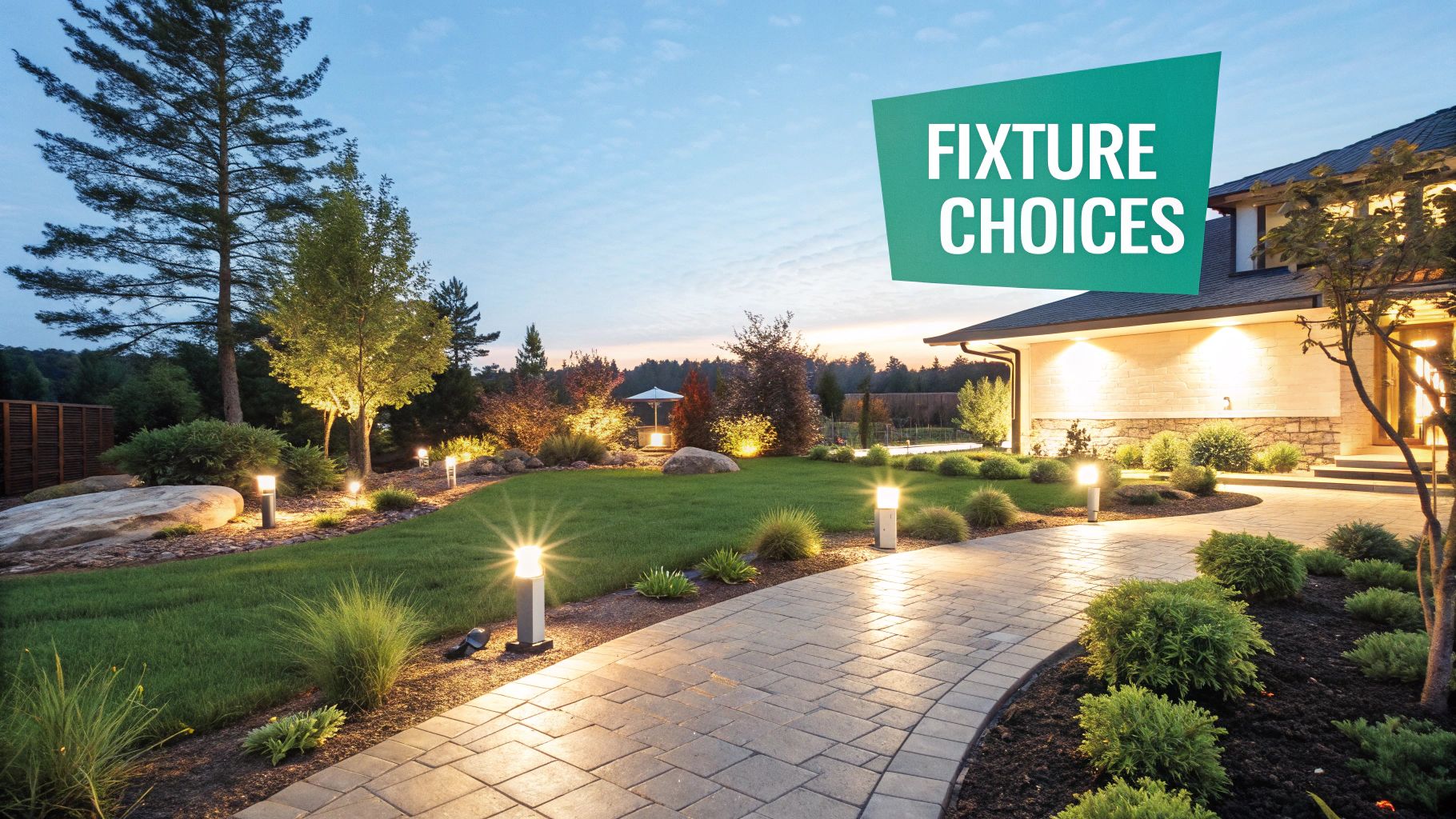
The first major fork in the road is deciding between traditional halogen and modern LED bulbs. For years, halogen was the go-to for its warm, familiar glow. But today, professional-grade LEDs have completely taken over as the champion for homeowners who want a system that’s durable, efficient, and saves money in the long run.
Halogen vs. LED: A Financial Snapshot
Sure, halogen bulbs are cheaper to buy at the outset. But that initial savings gets eaten up pretty quickly by higher energy bills and the constant need for replacements.
An LED system can use up to 80% less energy than a comparable halogen setup. That efficiency means lower monthly electric bills right away. It also lets us use a much smaller, more affordable transformer, cutting down your material costs from day one.
This incredible efficiency is then supercharged by their longevity. A high-quality LED bulb is rated to last somewhere between 25,000 to 40,000 hours. That could easily give you over a decade of beautiful light before you even think about a replacement. A halogen bulb? You’ll be lucky to get 2,000 to 3,600 hours out of it.
Here’s where you really see the long-term value:
- Energy Savings: Your stunning lighting design will barely make a dent in your utility bill, adding just a few dollars each month.
- Replacement Savings: You can forget about the recurring cost and annoyance of buying and swapping out bulbs every year or two.
- Durability: Professional-grade LEDs are simply built tougher and are far better equipped to handle the Orange County elements year-round.
Matching Fixtures to Functions and Budgets
Beyond just the bulb, the fixture's specific job determines its design, materials, and ultimately, its price. A great lighting plan isn't about plastering the same type of light everywhere. It’s about layering different kinds of fixtures to create depth, drama, and safety. Each type comes with a typical installed cost, which covers the fixture itself, the labor, and all the necessary hardware.
To get a feel for how these choices come together in a real-world design, take a look at some of our favorite outdoor lighting ideas to transform your landscape and see these concepts in action.
The True Value of Professional Installation
When you get a quote for landscape lighting, it's natural for your eyes to jump right to the "labor" line item. It often looks like a big number, but I encourage clients to see it for what it really is: an investment in expertise, safety, and longevity. It's the difference between a system that lasts and one that causes headaches down the road.
Think of it this way: anyone can buy a nice camera, but it takes a photographer to capture a stunning portrait. A professional lighting installer brings that same level of artistry and technical know-how to your home, creating something that’s not just functional, but truly beautiful and built to withstand the elements for years.
Beyond the Shovel: What Labor Costs Really Cover
Professional labor is about so much more than just digging trenches. It's about anticipating and solving problems that most DIY projects run right into. Here in Orange County, that often means dealing with rocky soil or carefully navigating the massive root systems of mature oak and sycamore trees. This kind of work takes skill and specialized equipment—it might add a bit to the installation time, but it’s absolutely essential for a stable, non-damaging setup.
What you're really paying for is the technical mastery that protects your investment in high-quality fixtures. This includes:
- Proper Voltage Calculations: A pro knows exactly how to calculate voltage drop over long wire runs, ensuring every single light gets the power it needs. This is the secret to consistent brightness and preventing bulbs from burning out prematurely.
- Watertight Connections: Moisture is the absolute worst enemy of any outdoor electrical system. We use professional-grade, silicone-filled wire nuts to create connections that can handle decades of rain and sprinkler spray without failing.
- Strategic and Safe Wiring: It's not just about hiding wires; it's about burying them at the proper depth to avoid being damaged by future gardening work. An expert ensures every part of the system is safely installed and properly grounded.
Hiring a professional isn't just about getting the job done; it's about getting it done right. You're buying peace of mind, knowing your system is safe, efficient, and designed to look amazing for over a decade.
Accounting for Other Potential Expenses
A good, transparent quote should account for everything, leaving no room for surprises. Beyond the fixtures and the labor to install them, a couple of other things can factor into the final cost. Let’s walk through them so you have the full picture.
Permits and Inspections
The good news is that for most low-voltage (12V) lighting systems, you won't need a permit here in Orange County. However, if your project is large enough to require a new dedicated circuit from your main electrical panel or involves any high-voltage (120V) work, a permit and inspection are usually mandatory. This is a safety measure to ensure everything is up to code, and it's an added cost your contractor will manage.
Smart Home Integration
These days, you can control your lights from anywhere. Integrating your new system with smart home platforms like Google Home or Alexa allows you to use voice commands, set complex schedules, and turn your lights on or off from your phone.
Here’s a quick look at the options and how they might affect your budget:
Control System TypeDescriptionEstimated Additional CostStandard TimerA simple digital or mechanical timer that turns lights on and off at the same time every day.$50 - $150Smart Plug/SwitchA Wi-Fi-connected device that gives you app and scheduling control for the whole system.$100 - $300Fully Integrated HubA dedicated control system for creating zones, dimming, and full smart home integration.$400 - $800+
Adding these features increases the upfront cost, but the convenience and control they offer are a huge plus for many homeowners. A good installer can help you decide what level of automation makes sense for you. To see how these elements fit into a larger strategy, taking a look at a professional's outdoor lighting plan and installation process can show you how it all comes together.
Smart Lighting and Its Impact on Your Investment
The future of outdoor lighting is already here, and it's all about smart technology. We've moved far beyond the simple on/off timer. Modern systems offer a level of control and efficiency that, just a few years ago, was only found in high-end commercial projects. These advancements are completely changing how we interact with our outdoor spaces and think about the initial investment.
Smart tech turns your lighting from a fixed, static feature into something dynamic and responsive. It's not just about the "cool factor" of turning lights on with your phone; it's about getting more value, security, and enjoyment out of your property.
The Tangible Benefits of Smart Technology
At the heart of this evolution is the perfect marriage of energy-sipping LEDs and automated control systems. While smart features do add to the upfront landscape lighting installation cost, they pay you back over the long haul. The most obvious return? A noticeable drop in your electricity bill.
Picture this: you're sitting on your couch and can change your home's entire outdoor vibe from an app. That's the new standard. With a few taps, you can dim the lights for a relaxing evening, set custom schedules for different seasons, or even switch to festive colors for the holidays. This fine-tuned control means you’re only using the exact amount of energy you need, right when you need it.
Integrating smart controls is a forward-thinking decision. It elevates your property from simply being lit to being intelligently illuminated, adding a layer of modern functionality that buyers increasingly expect.
These systems offer practical perks that directly affect your day-to-day life and your wallet. Being able to adjust your lighting doesn't just boost curb appeal; it makes your entire setup more efficient and secure.
Unlocking Advanced Control and Long-Term Value
The real magic of smart lighting is in its advanced features. Things like zoning, dimming, and full automation give you a level of control that pays for itself over the life of the system.
- Zoning: This lets you group lights together and control them as separate "zones." You could have one zone for the architectural lights on the front of your house, another for the backyard patio, and a third for the pathways—each running on its own schedule.
- Dimming: You don't always need your lights at 100% brightness. Dimming is perfect for setting the right mood, whether it's a quiet dinner or a lively get-together, all while saving energy.
- Automation: This is the "set it and forget it" feature. You can link your lights to motion sensors for an extra layer of security or have them automatically power on at sunset and off at sunrise. It’s all about convenience and peace of mind.
This shift toward smarter home upgrades is a huge trend in the outdoor living world. In fact, the global landscape lighting market is expected to keep growing, largely thanks to innovations in LEDs and smart controls. More and more, homeowners are looking for these modern features when they decide to beautify their properties. You can discover more about the landscape lighting market growth to see how these trends are shaping what people want.
At the end of the day, investing in smart lighting is about more than just looks. It’s a practical upgrade that fits right in with the larger movement toward sustainable, connected homes, making sure your property isn't just beautiful, but also functional and ready for the future.
Budgeting for Your Outdoor Lighting Project
Alright, you've seen what goes into a landscape lighting quote. Now for the fun part: figuring out a realistic budget that gets you the look you want without any sticker shock. Think of it less as an expense and more as a smart investment in your home. It’s all about matching your vision to what you’re comfortable spending.
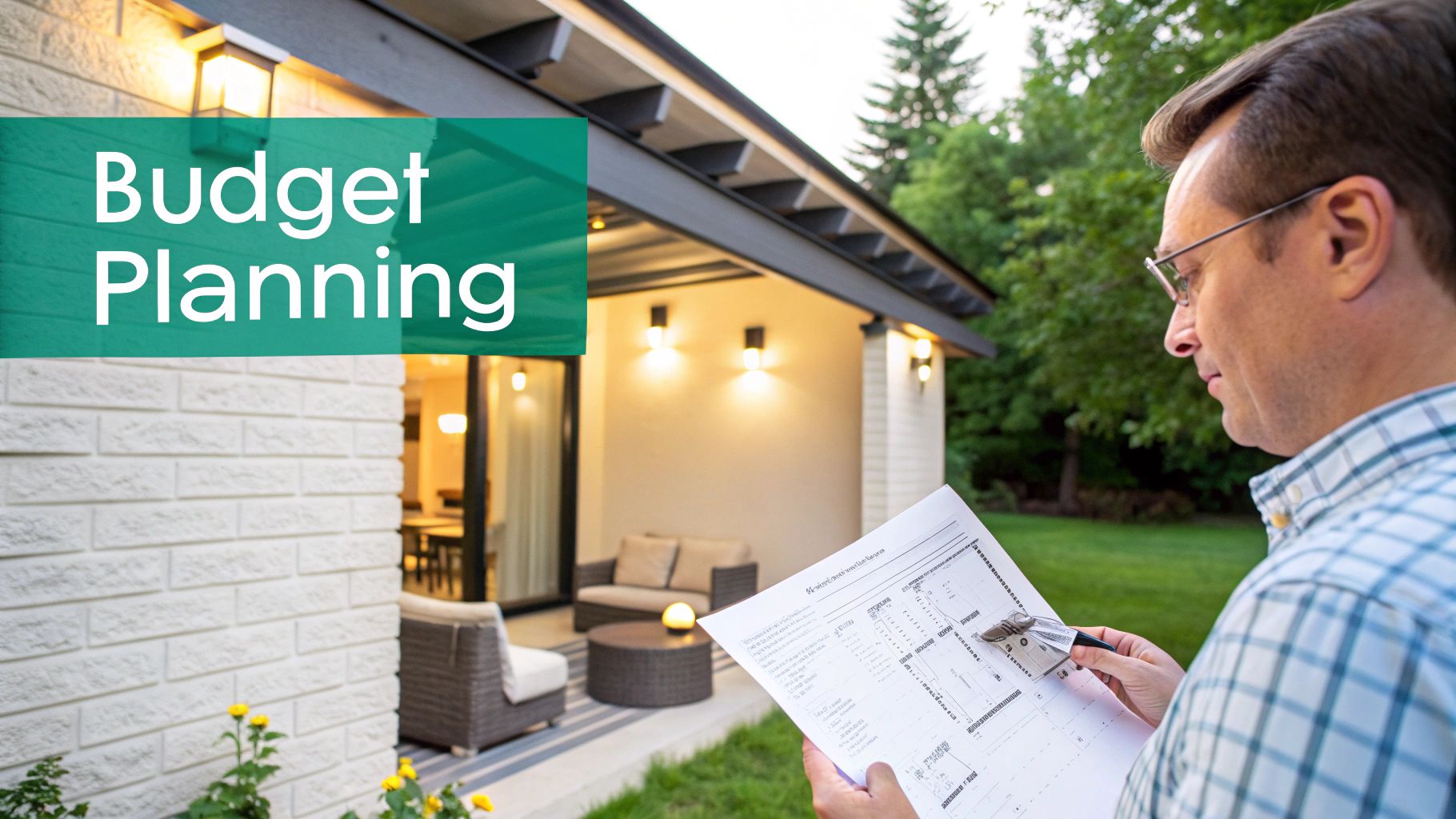
The best way to start is by asking a simple question: What job do I want my new lights to do? Answering that will immediately tell you where your money will have the biggest impact.
Define Your Project Priorities
Every great lighting plan I've ever seen started with a clear "why." Are you trying to make your house the star of the block? Create a cozy, private escape in the backyard? Or just make sure no one trips on the steps after dark? Each of these goals calls for a different strategy and, naturally, a different budget.
Most homeowners I work with fall into one of these camps:
- Curb Appeal: This is all about the front of your house. We'd focus on lighting up striking architectural features, your main entryway, and maybe a beautiful tree or two.
- Ambiance and Entertainment: Here, the action is in the back. The goal is to create that warm, inviting glow on patios, decks, and seating areas—perfect for hosting friends and family.
- Safety and Security: This is the most practical goal. We'd strategically light up pathways, stairs, and dark corners to help prevent trips and discourage anyone from lurking around.
Once you know your main objective, you can start making smarter choices about where every dollar goes.
Smart Strategies for a Manageable Budget
Here's a little secret: a stunning lighting system doesn't have to be a one-time, all-in purchase. One of the best ways to manage the landscape lighting installation cost is to phase the project. This lets you build out your dream design over time, as your budget allows.
For instance, you could light up the front of your home this year to nail that curb appeal. Next year, you can add lighting to the backyard patio and garden. You get the full vision, just in affordable stages.
When you're ready to get serious, make sure you get multiple quotes. I always tell people to aim for at least three detailed estimates from licensed, reputable contractors here in Orange County. This isn't just about finding the lowest price; it's about comparing the quality of the fixtures and understanding exactly what each contractor is proposing. While you're at it, ask about warranties—a long warranty is a great indicator of a quality product.
Finally, let's talk about LEDs. They might cost a little more at the outset, but you have to look at the long game. Their incredible energy efficiency and lifespan—some last up to 40,000 hours!—will save you a bundle on your electric bill and on buying replacements down the road. This kind of forward-thinking is just as important as the design itself, much like understanding the costs of regular garden maintenance is key to keeping your whole yard looking fantastic.
Common Questions About Lighting Costs
Even with a detailed plan in hand, it's completely normal to have a few questions about the final cost of a landscape lighting installation. Let's tackle some of the most common ones we hear from homeowners around Orange County to help you feel confident as you wrap up your decisions.
Can I Save Money with a DIY Installation?
It's tempting to think you can save a bundle by grabbing a DIY kit from the hardware store, and for a few simple solar stakes, that might be true. But for a complete, reliable system, a DIY approach comes with some serious risks.
A professional installation isn't just about sticking lights in the ground. It's about safety, calculating the correct voltage to protect your expensive fixtures, and creating durable, truly waterproof connections that won't fail after the first rainy season. An amateur job can become a fire hazard, cause your new lights to burn out prematurely, or lead to frustrating and costly repairs down the road.
The money you think you're saving on a DIY project can vanish in a heartbeat with the first repair bill. Investing in a pro is an investment in quality, safety, and your own peace of mind.
How Much Does It Cost to Run LED Lights?
This is where modern landscape lighting really shines. The cost to actually run a professional LED system is incredibly low—so low it often surprises people.
To put it in perspective, a typical 10-fixture professional LED system uses less electricity than a single, old-school 60-watt incandescent light bulb. For most homes, running a beautiful lighting setup for hours every night will only add a few dollars to your monthly electricity bill. It’s a sustainable luxury you can enjoy guilt-free all year long.
Will I Need a Permit for My Lighting Project?
For the vast majority of projects, the answer is no. Most professional landscape lighting systems are low-voltage (12V), which are designed for safety and don't fall under the strict permitting rules required for a home's main electrical system.
The exception? If your design involves high-voltage (120V) fixtures or requires a new dedicated circuit to be run from your home’s main electrical panel. In those cases, a permit and a licensed electrician are almost always required to ensure everything is up to code. Your contractor will know the local rules inside and out and can tell you exactly what’s needed for your specific plan.
Ready to transform your Orange County property with a stunning, professional lighting design? The team at All Seasons Sprinkler and Landscaping, Inc. has over 20 years of experience creating beautiful, durable, and safe outdoor lighting systems. Contact us today for a detailed estimate!


